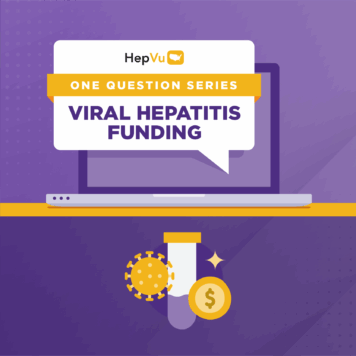Lauren Beste, MD MSc FACP, is the Director of the Data and Analytics Group for the Department of Veterans Affairs HIV, Hepatitis, and Related Conditions Program Office and Associate Professor of Medicine at University of Washington.
Q: You’ve spent much of your career researching the prevalence and treatment of viral hepatitis and liver cancer in U.S. Veterans. How did you get involved in this research area and why is it important to study this in the veteran population specifically?
I first became interested in viral hepatitis during my training to become a general internist. While working at a homeless clinic during my residency, I saw that very few patients who needed viral hepatitis treatment were actually receiving it. When I eventually moved to the Pacific Northwest to start my fellowship training in health services research, I knew that my focus had to be viral hepatitis.
Viral hepatitis disproportionately impacts Veterans’ health because so many are in the baby boomer birth cohort, or individuals born between 1945 and 1965 who historically have accounted for the largest proportion of persons in the U.S. living with chronic hepatitis C infection. As a Veterans Affairs (VA) provider, I have witnessed the downstream effects of viral hepatitis in one of the groups with highest prevalence of Hepatitis C in the U.S.
Q: According to the American Cancer Society, chronic Hepatitis B and Hepatitis C infections are some of the leading causes of liver cancer worldwide. What can you tell us about overall trends in liver cancer among Veterans who receive their care through the VA system? Are most cases of liver cancer among Veterans due to Hepatitis B and C or are there other underlying causes?
Most cases of liver cancer in the VA system are due to viral hepatitis, most often Hepatitis C, although we are starting to see an increase in liver cancer in patients with fatty liver disease as well. The impact of Hepatitis C, in particular, appears to be decreasing with time as more patients receive antiviral treatment. Currently, we are almost at 50/50 in the number of cases attributable to other causes versus those linked to viral hepatitis. In past years the proportion of cases caused by viral hepatitis was much higher.
Q: In 2017, you led a research study that focused on the impact of Veterans Affairs Extension for Community Health Outcomes (VA-ECHO), a telemedicine specialty support service, as a supplement to traditional primary care providers who offer Hepatitis C care. In this study, your team found that providers who joined the VA-ECHO program were positively associated with Hepatitis C treatment initiation of antiviral medication to patients. Considering the positive results of VA-ECHO, do you predict further developments in telehealth to improve access to care for viral hepatitis and liver cancer? patients, especially now that COVID-19 has expanded the use of telehealth?
This particular study showed that primary care providers who engaged with telemedicine support through VA-ECHO were able to deliver Hepatitis C treatment without any difference in cure rates compared to other patients. Additionally, the time to Hepatitis C treatment was shorter among whose providers who were engaged with VA-ECHO. These findings demonstrate that non-specialty providers are fully capable of treating patients with Hepatitis C, provided they receive adequate back-up and support, and that non-specialty providers can extend the health care system’s capacity for Hepatitis C treatment.
Across the country, I feel that many primary care providers are untapped resources in Hepatitis C care. We know that subspecialists such as infectious disease doctors and hepatologists are concentrated in urban areas, which limits treatment and care for patients not located in those regions. This telehealth study demonstrates that there are underutilized opportunities to expand and decentralize Hepatitis C treatment via non-specialty providers who can access specialists through consultation, if necessary. The VA-ECHO model has been replicated globally because it is an effective way to deliver Hepatitis C treatment and other services previously limited only to specialty care settings.
One of the few good things from the COVID-19 pandemic is that it has accelerated telemedicine. As telemedicine usage increases, I look forward to a greater role for it in future Hepatitis C treatment and care.
Q: In addition to employing telehealth, the VA has made use of nurse-practitioners and physician-assistants (along with other primary care providers) to expand HCV treatment capacity. Are there lessons from the VA experience that can be extended to other health systems? Did this practice also help address any issues with interruptions in Hepatitis C care delivery during COVID-19?
I think that the VA has tried diligently to maximize our existing resources. I do not believe that something as straightforward as Hepatitis C treatment needs to be done by a specialist or even necessarily by a physician. Primary care providers from many professions are capable of successfully delivering Hepatitis C treatment. And the outcomes for patients from non-physicians, like nurse-practitioners, are equal to those of physicians as long as the proper support and training have taken place.
In terms of COVID-19, we have not seen major interruptions in Hepatitis C care delivery because we have transitioned much of our face-to-face services to an online space. Fortunately, the VA already had existing infrastructure in place for video telehealth, which allowed us to quickly pivot to more virtual care for our Hepatitis C patients. Most of my current patients on Hepatitis C therapy only need to come to the hospital for lab work. Given the great work of the VA over the past few years to treat a majority of its viral hepatitis patients, the number of viral hepatitis patients we are seeing was already slowing down by the time COVID-19 started because most patients were already identified and/or treated previously.
Routine Hepatitis C screening does become tricky during the pandemic since we are not bringing patients in for as many blood draws or face-to-face visits in primary care. Fortunately, the VA’s Hepatitis C testing rates are extremely high. Before COVID-19, the VA had already screened more than 90% of the Hepatitis C birth cohort (baby boomers born between 1945 and 1965), and about 75% of all VA patients ages 18 to 79.
Q: Your most recent JAMA Network publication studied the incidence of liver cancer in Veterans Health Administration (VA) patients following Hepatitis C treatment using direct-acting antivirals. Could you highlight the study’s results and speak to how it impacts the current understanding of the Hepatitis C treatment and care, especially for Veterans?
This particular study looked at the number of cases of Hepatitis C-related liver cancers and non-Hepatitis C-related liver cancers from 2002 to 2018. Over time, we saw that there was a large spike in the number of antiviral treatments delivered, followed by a rapid decline in the incidence of Hepatitis C-related liver cancers within a few years.
We saw a 29% decline in Hepatitis C-related liver cancers in just three years after the peak point when we were treating the largest number of patients with Hepatitis C. In contrast, we also saw that the number of non-Hepatitis C-related cancers started to slowly trend in the opposite direction. These findings are observational and cannot prove a causal relationship, but they do provide strong indirect evidence that Hepatitis C treatment impacted rates of Hepatitis C-related cancers.
Q: Given your extensive experience with Veterans’ health, viral hepatitis, and liver cancer, what advice can you offer for other advocates and physicians to improve quality of life for those living with chronic liver conditions?
There are a lot of reasons to treat Hepatitis C—such as improving patients’ quality of life, reducing transmission to others, and reducing the risk of cirrhosis and liver cancer, which has an extremely high mortality. Unfortunately, treatment is expensive and viral hepatitis disproportionately affects marginalized groups.
I think the VA has done very well in confronting the challenges and resource barriers to treatment and offers an example for how other systems can do it. We were also fortunate to receive expanded funding to increase Hepatitis C drug treatment at VA facilities nationwide back in fiscal year 2016 to continue and expand our work. There are only rare situations when antiviral treatment is not medically appropriate, and for most patients the benefits far outweigh the costs in the long run. Health care professionals and patients alike should keep advocating for treatment access. It’s important to remember that virtually all patients, even those who have historically been considered “difficult to treat”, can successfully complete the therapy. Everyone’s efforts in treating Hepatitis C can save lives and prevent suffering for patients in the future.
*All responses are Dr. Beste’s individual views, and do not necessarily reflect the position or policy of the U.S. Department of Veterans Affairs or the University of Washington.




